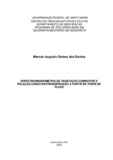| dc.creator | Santos, Marcos Augusto Gomes dos | |
| dc.date.accessioned | 2021-06-23T18:25:57Z | |
| dc.date.available | 2021-06-23T18:25:57Z | |
| dc.date.issued | 2020-01-16 | |
| dc.identifier.uri | http://repositorio.ufsm.br/handle/1/21200 | |
| dc.description.abstract | Evapotranspiration is an important natural phenomenon in the hydrological cycle since it is responsible for the production of water into the atmosphere. The term evapotranspiration carries two concepts that explain its action in the hydrological cycle, evaporation can be described as the water that evaporates from water bodies and portions of exposed soil and the transpiration that refers to the portion of water coming from the vegetation. The metabolic activity of vegetation can be indicated by obtained indices, known as Vegetation Indices (IV), based on their spectral behavior. This study evaluated relations between evapotranspiration (ET) obtained by the Turbulent Vortices Covariance (CVT) technique with indices obtained from remote sensing resources, such as Enhanced Vegetation Index 2 (EVI 2), Normalized Difference Vegetation Index (NDVI), Transformed Chlorophyll Absorption in Reflectance Index (TCARI) and Atmospherically Resistant Vegetation Index (ARVI), in native vegetation of the pampa biome. The experimental data were obtained in a native field area at the Federal University of Santa Maria (UFSM). The ET was estimated from a flow tower and field campaigns were performed to obtain vegetation reflectance values that were later converted into IV values. After identifying the ET and IV values, maps of their distributions in space and time were generated and the relationships between ET and EVI2, NDVI, TCARI, ARVI were known. The results revealed the existence of a good relationship between ET and NDVI, TCARI, EVI2 and a low relationship with ARVI. It was concluded that the relationships established suggests that studies on this theme, when carried out with an adequate “n” sample, can identify equations to estimate ET using only vegetation indices. | eng |
| dc.description.sponsorship | capes | por |
| dc.description.sponsorship | Conselho Nacional de Pesquisa e Desenvolvimento Científico e Tecnológico - CNPq | por |
| dc.language | por | por |
| dc.publisher | Universidade Federal de Santa Maria | por |
| dc.rights | Attribution-NonCommercial-NoDerivatives 4.0 International | * |
| dc.rights.uri | http://creativecommons.org/licenses/by-nc-nd/4.0/ | * |
| dc.subject | Espectrorradiometria | por |
| dc.title | Espectrorradiometria de vegetação campestre e relação com evapotranspiração a partir de torre de fluxo | por |
| dc.title.alternative | Campaign evapotranspiration estimate from remote sensing | eng |
| dc.type | Dissertação | por |
| dc.description.resumo | A evapotranspiração é um fenômeno natural importante do ciclo hidrológico, pois é a responsável pela produção de água para a atmosfera. O termo evapotranspiração carrega dois conceitos que explicam sua ação no ciclo hidrológico, a evaporação que pode ser descrita como a água que evapora de corpos d'água e de porções de solo exposto, e a transpiração que se refere a parcela de água proveniente da vegetação. A atividade metabólica da vegetação pode ser indicada por índices obtidos, conhecidos por Índices de Vegetação (IV), baseados no seu comportamento espectral. Este estudo avaliou relações entre a evapotranspiração (ET) obtida pela técnica de Covariância de Vórtices Turbulentos (CVT) com índices obtidos com recursos de sensoriamento remoto, tais como, Enhanced Vegetation Index 2 (EVI 2), Normalized Difference Vegetation Index (NDVI), Transformed Chlorophyll Absorption in Reflectance Index (TCARI) e Atmospherically Resistant Vegetation Index (ARVI), em vegetação nativa do bioma pampa. Os dados experimentais foram obtidos em uma área de campo nativo da Universidade Federal de Santa Maria (UFSM). A ET foi estimada de uma torre de fluxo e missões de campo foram realizadas para obtenção de valores de reflectância da vegetação que posteriormente foram convertidos em valores de IVs. Após a identificação dos valores de ET e IVs gerou-se mapas das suas distribuições no espaço e no tempo e identificadas as relações entre ET com EVI2, NDVI, TCARI, ARVI. Os resultados revelaram existência de boa relação da ET com NDVI, TCARI, EVI2 e baixa relação com ARVI. Concluiu-se que as relações estabelecidas sugerem que estudos neste tema, quando realizado com “n” amostral adequado, podem identificar equações para estimar ET apenas utilizando índices de vegetação. | por |
| dc.contributor.advisor1 | Pereira Filho, Waterloo | |
| dc.contributor.advisor1Lattes | http://lattes.cnpq.br/0357112879415627 | por |
| dc.contributor.referee1 | Viera, Valmir | |
| dc.contributor.referee2 | Kuplich, Tatiana Mora | |
| dc.creator.Lattes | http://lattes.cnpq.br/1913032986275877 | por |
| dc.publisher.country | Brasil | por |
| dc.publisher.department | Geografia | por |
| dc.publisher.initials | UFSM | por |
| dc.publisher.program | Programa de Pós-Graduação em Geografia | por |
| dc.subject.cnpq | CNPQ::CIENCIAS HUMANAS::GEOGRAFIA | por |
| dc.publisher.unidade | Centro de Ciências Naturais e Exatas | por |



